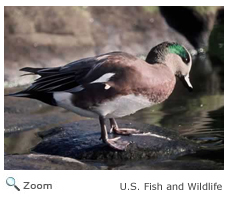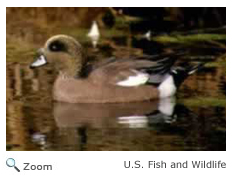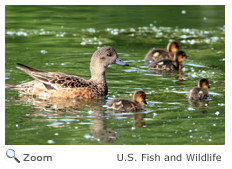Characteristics
 The American wigeon is 18-23 inches in length with a wingspan of 33 inches. The male has a brown back and chest, a black rear and tail tip, and a white belly. He has a white crown and forehead and an iridescent green patch that runs over his eyes to the back of his neck. The American wigeon is 18-23 inches in length with a wingspan of 33 inches. The male has a brown back and chest, a black rear and tail tip, and a white belly. He has a white crown and forehead and an iridescent green patch that runs over his eyes to the back of his neck.
The female is mottled brown with a brownish-gray head. Both the male and female have white shoulder patches that are visible when they are in flight, and they both have a stubby, bluish-gray bill with a black tip and bluish-gray legs and feet. The American wigeon is also known as the baldpate because of the white crown and forehead on the male.
Range
 The American wigeon breeds from western Canada into the American Northwest. It winters mainly along the Pacific, Atlantic, and Gulf coasts and is found throughout the United States during migration. The American wigeon breeds from western Canada into the American Northwest. It winters mainly along the Pacific, Atlantic, and Gulf coasts and is found throughout the United States during migration.
Habitat
The American wigeon can be found in
freshwater marshes, lakes, rivers, ponds, saltwater bays and estuaries. |
| |
Diet
 The American wigeon is a dabbling duck. It feeds on plant matter on or just below the surface of the water. It eats the seeds, stems, and leafy parts of aquatic plants. Its short, stubby bill helps it exert force on plants, making it easier to pull off stems and leaves. It also eats insects, mollusks, and crustaceans. The American wigeon sometimes eats the seeds and shoots of plants in grain fields and meadows. The American wigeon is a dabbling duck. It feeds on plant matter on or just below the surface of the water. It eats the seeds, stems, and leafy parts of aquatic plants. Its short, stubby bill helps it exert force on plants, making it easier to pull off stems and leaves. It also eats insects, mollusks, and crustaceans. The American wigeon sometimes eats the seeds and shoots of plants in grain fields and meadows.
Life Cycle
 The female selects a nesting site. The nest is made of grass and plant stems and lined with down. The nest is made in the tall grass or in shrubs or other plant cover. The nest is often placed far from the water. The female lays 3-11 eggs. The eggs hatch in about 25 days. The hatchlings are precocial and leave the nest and feed themselves a day after hatching. They fledge when they are 35-48 days old.
In the wild, the American wigeon has a life span of around two years. The female selects a nesting site. The nest is made of grass and plant stems and lined with down. The nest is made in the tall grass or in shrubs or other plant cover. The nest is often placed far from the water. The female lays 3-11 eggs. The eggs hatch in about 25 days. The hatchlings are precocial and leave the nest and feed themselves a day after hatching. They fledge when they are 35-48 days old.
In the wild, the American wigeon has a life span of around two years.
Behavior
 The American wigeon often tags along behind diving birds, waiting on the surface of the water to snatch up the plants that the diving birds pull up! The American wigeon often tags along behind diving birds, waiting on the surface of the water to snatch up the plants that the diving birds pull up!
|